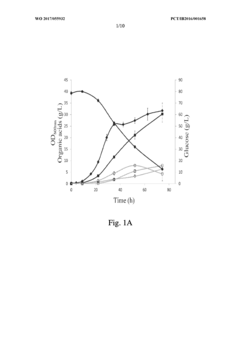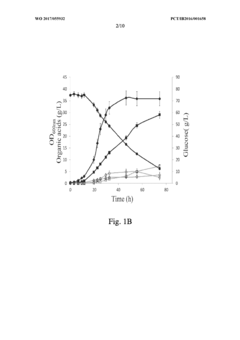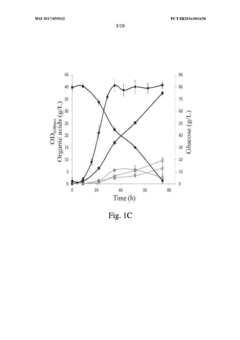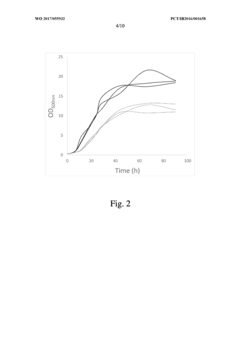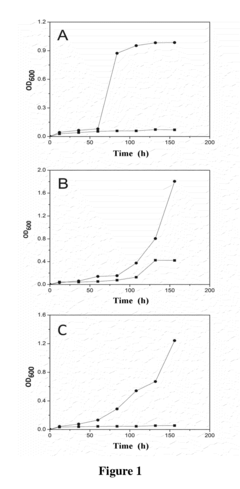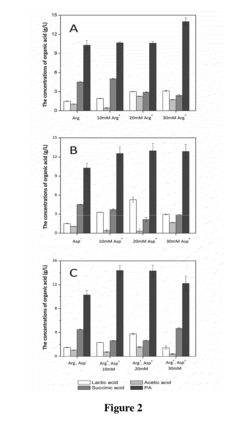How to Lead Propionic Acid Innovations in Food Safety?
JUL 3, 20259 MIN READ
Generate Your Research Report Instantly with AI Agent
Patsnap Eureka helps you evaluate technical feasibility & market potential.
Propionic Acid in Food Safety: Background and Objectives
Propionic acid has emerged as a crucial component in the realm of food safety, playing a significant role in preserving food products and extending their shelf life. This organic compound, naturally occurring in some foods and produced by bacteria in the human gut, has gained prominence in the food industry due to its antimicrobial properties and effectiveness against a wide range of microorganisms.
The evolution of propionic acid in food safety can be traced back to the early 20th century when its preservative qualities were first recognized. Since then, its applications have expanded considerably, encompassing various sectors of the food industry, including bakery products, dairy items, and processed meats. The growing demand for natural preservatives and clean label products has further propelled the interest in propionic acid and its derivatives.
In recent years, the global food safety landscape has undergone significant changes, driven by increasing consumer awareness, stringent regulations, and the need for more sustainable preservation methods. These factors have created a fertile ground for innovations in propionic acid applications, pushing researchers and industry professionals to explore novel approaches and formulations.
The primary objective of propionic acid innovations in food safety is to enhance its efficacy while addressing the challenges associated with its use. These challenges include improving its solubility, reducing its characteristic odor, and optimizing its performance across different food matrices. Additionally, there is a growing emphasis on developing synergistic combinations with other preservatives to create more robust and versatile food safety solutions.
Another key goal is to expand the application spectrum of propionic acid beyond its traditional uses. This involves exploring its potential in new food categories, such as plant-based products and functional foods, where maintaining product integrity and safety is paramount. Furthermore, there is a focus on leveraging propionic acid's natural origins to align with the clean label trend and meet consumer demands for minimally processed foods.
As we delve into the realm of propionic acid innovations, it is crucial to consider the broader context of food safety challenges, including the emergence of new foodborne pathogens, the globalization of food supply chains, and the increasing complexity of food formulations. These factors underscore the need for continuous innovation and adaptation in preservation strategies, with propionic acid playing a pivotal role in this evolving landscape.
The evolution of propionic acid in food safety can be traced back to the early 20th century when its preservative qualities were first recognized. Since then, its applications have expanded considerably, encompassing various sectors of the food industry, including bakery products, dairy items, and processed meats. The growing demand for natural preservatives and clean label products has further propelled the interest in propionic acid and its derivatives.
In recent years, the global food safety landscape has undergone significant changes, driven by increasing consumer awareness, stringent regulations, and the need for more sustainable preservation methods. These factors have created a fertile ground for innovations in propionic acid applications, pushing researchers and industry professionals to explore novel approaches and formulations.
The primary objective of propionic acid innovations in food safety is to enhance its efficacy while addressing the challenges associated with its use. These challenges include improving its solubility, reducing its characteristic odor, and optimizing its performance across different food matrices. Additionally, there is a growing emphasis on developing synergistic combinations with other preservatives to create more robust and versatile food safety solutions.
Another key goal is to expand the application spectrum of propionic acid beyond its traditional uses. This involves exploring its potential in new food categories, such as plant-based products and functional foods, where maintaining product integrity and safety is paramount. Furthermore, there is a focus on leveraging propionic acid's natural origins to align with the clean label trend and meet consumer demands for minimally processed foods.
As we delve into the realm of propionic acid innovations, it is crucial to consider the broader context of food safety challenges, including the emergence of new foodborne pathogens, the globalization of food supply chains, and the increasing complexity of food formulations. These factors underscore the need for continuous innovation and adaptation in preservation strategies, with propionic acid playing a pivotal role in this evolving landscape.
Market Analysis for Propionic Acid in Food Preservation
The global market for propionic acid in food preservation is experiencing steady growth, driven by increasing consumer demand for safe, natural, and long-lasting food products. As a key preservative in the food industry, propionic acid plays a crucial role in extending shelf life and maintaining food quality, particularly in bakery products, dairy items, and animal feed.
Market analysis indicates that the food and beverage sector remains the primary consumer of propionic acid, accounting for a significant portion of its total demand. The bakery industry, in particular, has shown a strong uptake of propionic acid as a preservative, owing to its effectiveness in preventing mold growth and bacterial contamination in bread and other baked goods.
The dairy industry also represents a substantial market for propionic acid, where it is used to preserve cheese and other dairy products. With the growing popularity of cheese consumption worldwide, this segment is expected to contribute significantly to market growth in the coming years.
In the animal feed sector, propionic acid is widely used as a mold inhibitor and feed preservative. The increasing focus on animal nutrition and the expansion of the livestock industry in developing countries are driving the demand for propionic acid in this application.
Geographically, North America and Europe currently dominate the propionic acid market for food preservation, due to stringent food safety regulations and high consumer awareness. However, the Asia-Pacific region is emerging as a rapidly growing market, fueled by changing dietary habits, increasing disposable incomes, and a growing food processing industry.
Market trends indicate a shift towards natural and clean-label preservatives, which presents both challenges and opportunities for propionic acid manufacturers. While propionic acid is considered a synthetic preservative, its natural occurrence in some foods and its effectiveness at low concentrations make it an attractive option for food producers seeking to balance safety, shelf life, and consumer preferences.
The competitive landscape of the propionic acid market is characterized by the presence of several key players, including BASF SE, Dow Inc., and Eastman Chemical Company. These companies are investing in research and development to improve production processes and develop new applications for propionic acid in food preservation.
Future market growth is expected to be driven by innovations in formulation and application techniques, as well as the development of propionic acid derivatives that offer enhanced functionality or improved sensory properties. Additionally, the increasing adoption of propionic acid in emerging economies and its potential applications in new food categories present significant opportunities for market expansion.
Market analysis indicates that the food and beverage sector remains the primary consumer of propionic acid, accounting for a significant portion of its total demand. The bakery industry, in particular, has shown a strong uptake of propionic acid as a preservative, owing to its effectiveness in preventing mold growth and bacterial contamination in bread and other baked goods.
The dairy industry also represents a substantial market for propionic acid, where it is used to preserve cheese and other dairy products. With the growing popularity of cheese consumption worldwide, this segment is expected to contribute significantly to market growth in the coming years.
In the animal feed sector, propionic acid is widely used as a mold inhibitor and feed preservative. The increasing focus on animal nutrition and the expansion of the livestock industry in developing countries are driving the demand for propionic acid in this application.
Geographically, North America and Europe currently dominate the propionic acid market for food preservation, due to stringent food safety regulations and high consumer awareness. However, the Asia-Pacific region is emerging as a rapidly growing market, fueled by changing dietary habits, increasing disposable incomes, and a growing food processing industry.
Market trends indicate a shift towards natural and clean-label preservatives, which presents both challenges and opportunities for propionic acid manufacturers. While propionic acid is considered a synthetic preservative, its natural occurrence in some foods and its effectiveness at low concentrations make it an attractive option for food producers seeking to balance safety, shelf life, and consumer preferences.
The competitive landscape of the propionic acid market is characterized by the presence of several key players, including BASF SE, Dow Inc., and Eastman Chemical Company. These companies are investing in research and development to improve production processes and develop new applications for propionic acid in food preservation.
Future market growth is expected to be driven by innovations in formulation and application techniques, as well as the development of propionic acid derivatives that offer enhanced functionality or improved sensory properties. Additionally, the increasing adoption of propionic acid in emerging economies and its potential applications in new food categories present significant opportunities for market expansion.
Current Challenges in Propionic Acid Application
Despite the widespread use of propionic acid as a food preservative, several challenges persist in its application for food safety. One of the primary concerns is the potential development of resistance in microorganisms. As propionic acid has been used extensively in the food industry for decades, there is growing evidence that certain strains of bacteria and fungi are developing resistance to its antimicrobial effects. This resistance could potentially compromise the efficacy of propionic acid as a preservative, leading to reduced shelf life and increased food safety risks.
Another significant challenge is the organoleptic impact of propionic acid on food products. While effective as a preservative, propionic acid can impart a distinct flavor and aroma to foods, which may be undesirable in certain applications. This limitation restricts its use in sensitive food products where taste and smell are crucial factors. Balancing the preservative efficacy with sensory acceptability remains a complex task for food manufacturers.
The regulatory landscape surrounding propionic acid usage also presents challenges. Different countries and regions have varying regulations regarding the permissible levels of propionic acid in food products. These regulatory discrepancies can create complications for food companies operating in global markets, necessitating the development of region-specific formulations and potentially increasing production costs.
Environmental concerns associated with the production and use of propionic acid are also emerging as a challenge. The traditional petrochemical-based production methods for propionic acid have a significant carbon footprint. As sustainability becomes an increasingly important factor in the food industry, there is growing pressure to develop more environmentally friendly production methods and alternatives.
Furthermore, the interaction of propionic acid with other food components and additives is not fully understood in all food matrices. This lack of comprehensive knowledge can lead to unexpected chemical reactions or reduced efficacy in complex food systems. Research is needed to elucidate these interactions and optimize the use of propionic acid in diverse food formulations.
Lastly, there is a growing consumer demand for "clean label" products with minimal artificial additives. Although propionic acid is considered a natural preservative, its chemical name can be perceived negatively by consumers seeking "all-natural" products. This perception challenge requires innovative approaches in product formulation and marketing to maintain consumer acceptance while ensuring food safety.
Another significant challenge is the organoleptic impact of propionic acid on food products. While effective as a preservative, propionic acid can impart a distinct flavor and aroma to foods, which may be undesirable in certain applications. This limitation restricts its use in sensitive food products where taste and smell are crucial factors. Balancing the preservative efficacy with sensory acceptability remains a complex task for food manufacturers.
The regulatory landscape surrounding propionic acid usage also presents challenges. Different countries and regions have varying regulations regarding the permissible levels of propionic acid in food products. These regulatory discrepancies can create complications for food companies operating in global markets, necessitating the development of region-specific formulations and potentially increasing production costs.
Environmental concerns associated with the production and use of propionic acid are also emerging as a challenge. The traditional petrochemical-based production methods for propionic acid have a significant carbon footprint. As sustainability becomes an increasingly important factor in the food industry, there is growing pressure to develop more environmentally friendly production methods and alternatives.
Furthermore, the interaction of propionic acid with other food components and additives is not fully understood in all food matrices. This lack of comprehensive knowledge can lead to unexpected chemical reactions or reduced efficacy in complex food systems. Research is needed to elucidate these interactions and optimize the use of propionic acid in diverse food formulations.
Lastly, there is a growing consumer demand for "clean label" products with minimal artificial additives. Although propionic acid is considered a natural preservative, its chemical name can be perceived negatively by consumers seeking "all-natural" products. This perception challenge requires innovative approaches in product formulation and marketing to maintain consumer acceptance while ensuring food safety.
Existing Propionic Acid Solutions for Food Safety
01 Production methods of propionic acid
Various methods are employed for the production of propionic acid, including fermentation processes, chemical synthesis, and catalytic reactions. These methods often involve the use of specific microorganisms, catalysts, or chemical precursors to efficiently produce propionic acid on an industrial scale.- Production methods of propionic acid: Various methods for producing propionic acid are described, including fermentation processes, chemical synthesis routes, and catalytic reactions. These methods aim to improve yield, efficiency, and purity of propionic acid production for industrial applications.
- Applications of propionic acid in food preservation: Propionic acid and its derivatives are widely used as food preservatives due to their antimicrobial properties. They are effective in preventing mold growth and extending the shelf life of various food products, particularly in bakery items and dairy products.
- Use of propionic acid in pharmaceutical formulations: Propionic acid and its salts are utilized in pharmaceutical compositions for various therapeutic purposes. They may be incorporated into drug formulations as active ingredients or excipients, contributing to the stability and efficacy of medications.
- Propionic acid derivatives and their synthesis: Research focuses on developing new propionic acid derivatives and improving synthesis methods for existing ones. These derivatives may have enhanced properties or specific applications in various industries, including pharmaceuticals, agriculture, and materials science.
- Environmental and safety considerations in propionic acid production: Efforts are made to develop environmentally friendly production methods for propionic acid and to improve safety measures in its handling and storage. This includes the use of green chemistry principles, waste reduction strategies, and the development of safer production processes.
02 Applications of propionic acid in food preservation
Propionic acid and its salts are widely used as food preservatives due to their antimicrobial properties. They are effective in preventing mold growth and extending the shelf life of various food products, particularly in baked goods, dairy products, and animal feed.Expand Specific Solutions03 Use of propionic acid in pharmaceutical and cosmetic industries
Propionic acid finds applications in the pharmaceutical and cosmetic industries. It is used as a precursor in the synthesis of certain drugs and as a pH adjuster in various formulations. In cosmetics, it may be used as a preservative or in the production of other ingredients.Expand Specific Solutions04 Environmental and agricultural applications of propionic acid
Propionic acid has applications in environmental and agricultural sectors. It is used in the treatment of wastewater, as a herbicide, and in the production of biodegradable plastics. In agriculture, it can be used as a feed additive to improve animal health and productivity.Expand Specific Solutions05 Purification and analysis techniques for propionic acid
Various methods are employed for the purification and analysis of propionic acid. These include distillation, crystallization, and chromatographic techniques. Analytical methods such as gas chromatography and spectroscopy are used to determine the purity and concentration of propionic acid in different samples.Expand Specific Solutions
Key Players in Propionic Acid Industry
The propionic acid innovation landscape in food safety is characterized by a competitive market in its growth phase, with increasing demand driven by heightened food safety concerns. The global market size for propionic acid in food preservation is expanding, estimated to reach several hundred million dollars by 2025. Technologically, the field is moderately mature, with established players like BASF, Dow, and Perstorp leading in production. However, there's ongoing innovation, particularly in natural and sustainable alternatives. Academic institutions such as Jiangnan University, Zhejiang University, and The Ohio State University are contributing to research advancements. Companies like Kemin Industries and Danone are exploring novel applications, while startups are emerging with bio-based solutions, indicating a dynamic and evolving competitive landscape.
Purac Biochem BV
Technical Solution: Purac Biochem BV, a subsidiary of Corbion, has developed innovative solutions for propionic acid in food safety. They have created a range of natural preservation solutions based on propionic acid and its salts. Their PURASAL® product line includes calcium and sodium propionate, which effectively inhibit mold growth in various food products[1]. Purac has also developed a patented fermentation process to produce propionic acid from renewable resources, reducing environmental impact[2]. Their research focuses on optimizing the antimicrobial efficacy of propionic acid derivatives in different food matrices, considering factors such as pH, water activity, and temperature[3].
Strengths: Extensive experience in fermentation technology, natural preservation solutions, and sustainable production methods. Weaknesses: May face competition from synthetic preservative manufacturers and need to continually innovate to maintain market position.
Kemin Industries, Inc.
Technical Solution: Kemin Industries has made significant strides in propionic acid innovations for food safety. They have developed a line of mold inhibitors under the SHIELD® brand, which utilizes propionic acid and its salts as key active ingredients[4]. Kemin's research has focused on synergistic blends of propionic acid with other organic acids and antioxidants to enhance antimicrobial efficacy and extend shelf life[5]. They have also invested in encapsulation technologies to improve the stability and controlled release of propionic acid in various food applications[6]. Kemin's approach includes comprehensive stability testing and challenge studies to validate the performance of their propionic acid-based solutions in different food systems.
Strengths: Strong focus on research and development, customized solutions for different food industries, and global presence. Weaknesses: May face challenges in regulatory approvals for novel formulations and need to address consumer demand for clean label products.
Innovative Propionic Acid Formulations
Improved propionibacterium strains for the production of propionic acid
PatentWO2017055932A2
Innovation
- Genome shuffling between selected Propionibacterium strains, such as P. acidipropionici ATCC 4875 and P. acidipropionici ATCC 55737, to generate novel strains with enhanced growth rates and propionic acid production, utilizing genetic material exchange to create strains with improved metabolic pathways and regulatory mechanisms.
Method for Improving Acid tolerance of Propionibacterium acdipropionici
PatentInactiveUS20140178952A1
Innovation
- Adding arginine and/or aspartic acid to the culture medium during the cultivation of Propionibacterium acdipropionici to enhance acid tolerance and propionic acid productivity.
Regulatory Framework for Food Preservatives
The regulatory framework for food preservatives plays a crucial role in ensuring food safety and guiding innovations in the field of propionic acid. In the United States, the Food and Drug Administration (FDA) oversees the regulation of food additives, including preservatives like propionic acid. The FDA's Generally Recognized as Safe (GRAS) designation allows for the use of propionic acid and its salts in various food applications, subject to specific limitations and conditions.
The European Union (EU) has established its own regulatory framework through the European Food Safety Authority (EFSA). The EFSA evaluates the safety of food additives and sets maximum permitted levels for their use. Propionic acid and propionates are authorized food additives in the EU, with E-numbers E280, E281, E282, and E283 assigned to them.
Globally, the Codex Alimentarius Commission, established by the Food and Agriculture Organization (FAO) and the World Health Organization (WHO), provides international food standards, guidelines, and codes of practice. These standards serve as a reference for many countries in developing their national regulations for food preservatives.
Regulatory bodies typically require extensive safety data and scientific evidence to support the use of preservatives in food products. This includes toxicological studies, exposure assessments, and efficacy data. For propionic acid innovations, compliance with these regulatory requirements is essential for market approval and consumer acceptance.
The regulatory landscape also influences research and development efforts in propionic acid innovations. Manufacturers must consider regulatory constraints when developing new formulations or applications. This often leads to a focus on optimizing the use of propionic acid within existing regulatory limits or exploring novel combinations with other approved preservatives.
Emerging trends in food safety regulations, such as the push for clean label products and natural preservatives, are shaping the direction of propionic acid innovations. Regulatory bodies are increasingly scrutinizing synthetic preservatives, prompting research into naturally derived propionic acid or alternative preservation methods that can work synergistically with propionic acid.
As food safety concerns evolve, regulatory frameworks are adapting to address new challenges. This includes considerations for antimicrobial resistance, novel food processing technologies, and the use of propionic acid in new food categories. Staying abreast of these regulatory developments is crucial for companies seeking to lead propionic acid innovations in food safety.
The European Union (EU) has established its own regulatory framework through the European Food Safety Authority (EFSA). The EFSA evaluates the safety of food additives and sets maximum permitted levels for their use. Propionic acid and propionates are authorized food additives in the EU, with E-numbers E280, E281, E282, and E283 assigned to them.
Globally, the Codex Alimentarius Commission, established by the Food and Agriculture Organization (FAO) and the World Health Organization (WHO), provides international food standards, guidelines, and codes of practice. These standards serve as a reference for many countries in developing their national regulations for food preservatives.
Regulatory bodies typically require extensive safety data and scientific evidence to support the use of preservatives in food products. This includes toxicological studies, exposure assessments, and efficacy data. For propionic acid innovations, compliance with these regulatory requirements is essential for market approval and consumer acceptance.
The regulatory landscape also influences research and development efforts in propionic acid innovations. Manufacturers must consider regulatory constraints when developing new formulations or applications. This often leads to a focus on optimizing the use of propionic acid within existing regulatory limits or exploring novel combinations with other approved preservatives.
Emerging trends in food safety regulations, such as the push for clean label products and natural preservatives, are shaping the direction of propionic acid innovations. Regulatory bodies are increasingly scrutinizing synthetic preservatives, prompting research into naturally derived propionic acid or alternative preservation methods that can work synergistically with propionic acid.
As food safety concerns evolve, regulatory frameworks are adapting to address new challenges. This includes considerations for antimicrobial resistance, novel food processing technologies, and the use of propionic acid in new food categories. Staying abreast of these regulatory developments is crucial for companies seeking to lead propionic acid innovations in food safety.
Environmental Impact of Propionic Acid Production
The production of propionic acid, while essential for food safety innovations, carries significant environmental implications that warrant careful consideration. The primary manufacturing process for propionic acid involves the oxidation of propionaldehyde, which is derived from ethylene and carbon monoxide. This petrochemical-based production method contributes to greenhouse gas emissions and relies on non-renewable resources.
The energy-intensive nature of propionic acid production results in a substantial carbon footprint. The process requires high temperatures and pressures, leading to increased energy consumption and associated CO2 emissions. Additionally, the use of catalysts in the production process may lead to the generation of hazardous waste materials that require proper disposal or treatment.
Water usage and potential contamination are also environmental concerns in propionic acid production. The manufacturing process often involves water-intensive steps, and improper handling of wastewater can lead to the release of organic compounds and other pollutants into local water systems. This necessitates robust water treatment protocols to mitigate environmental impact.
The transportation and storage of propionic acid present further environmental challenges. As a corrosive substance, propionic acid requires specialized containment and handling procedures to prevent accidental spills or leaks that could harm ecosystems. The global distribution of propionic acid also contributes to transportation-related emissions.
However, it is important to note that the use of propionic acid in food preservation can indirectly contribute to environmental sustainability. By extending the shelf life of food products, propionic acid helps reduce food waste, which is a significant contributor to greenhouse gas emissions when disposed of in landfills.
Efforts to mitigate the environmental impact of propionic acid production are ongoing. Research into bio-based production methods, using renewable feedstocks such as biomass or agricultural waste, shows promise in reducing the reliance on petrochemical sources. These alternative production routes could potentially lower the carbon footprint and decrease the overall environmental impact of propionic acid manufacturing.
Advancements in process efficiency and green chemistry principles are also being applied to traditional production methods. This includes the development of more selective catalysts, improved reactor designs, and the implementation of heat recovery systems to reduce energy consumption. Such innovations aim to minimize waste generation and optimize resource utilization in propionic acid production.
The energy-intensive nature of propionic acid production results in a substantial carbon footprint. The process requires high temperatures and pressures, leading to increased energy consumption and associated CO2 emissions. Additionally, the use of catalysts in the production process may lead to the generation of hazardous waste materials that require proper disposal or treatment.
Water usage and potential contamination are also environmental concerns in propionic acid production. The manufacturing process often involves water-intensive steps, and improper handling of wastewater can lead to the release of organic compounds and other pollutants into local water systems. This necessitates robust water treatment protocols to mitigate environmental impact.
The transportation and storage of propionic acid present further environmental challenges. As a corrosive substance, propionic acid requires specialized containment and handling procedures to prevent accidental spills or leaks that could harm ecosystems. The global distribution of propionic acid also contributes to transportation-related emissions.
However, it is important to note that the use of propionic acid in food preservation can indirectly contribute to environmental sustainability. By extending the shelf life of food products, propionic acid helps reduce food waste, which is a significant contributor to greenhouse gas emissions when disposed of in landfills.
Efforts to mitigate the environmental impact of propionic acid production are ongoing. Research into bio-based production methods, using renewable feedstocks such as biomass or agricultural waste, shows promise in reducing the reliance on petrochemical sources. These alternative production routes could potentially lower the carbon footprint and decrease the overall environmental impact of propionic acid manufacturing.
Advancements in process efficiency and green chemistry principles are also being applied to traditional production methods. This includes the development of more selective catalysts, improved reactor designs, and the implementation of heat recovery systems to reduce energy consumption. Such innovations aim to minimize waste generation and optimize resource utilization in propionic acid production.
Unlock deeper insights with Patsnap Eureka Quick Research — get a full tech report to explore trends and direct your research. Try now!
Generate Your Research Report Instantly with AI Agent
Supercharge your innovation with Patsnap Eureka AI Agent Platform!
